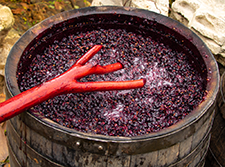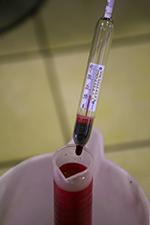Balancing High Alcohol Levels in Winemaking
Posted by Matteo Lahm on 13th Apr 2023
You just bought your fresh Cabernet grapes home, took an OSG reading and your hydrometer is having palpitations. Your brix are 27! It’s going to be a “hot” red wine. That much alcohol will be unruly on your palette if you don’t plan to accommodate it. You will need higher tannins, more oak and additional fruit forwardness to harmoneously balance out the flavor profile of your budding masterpiece. In previous posts, the importance of tuning acidy has been highlighted but, planning for alcohol levels is equally important.
When calculating ABV, it is easy to think there is not much of a difference between 12.5 and 14%. The truth is quite the contrary. A 12.5 ABV is 25 parts if you count .5 as a unit of measurement. It may only be 1.5% of the total solution but If you think about the alcohol content as an individual measurement, it tells a different story. The increase to 14% ABV is 9.25% more alcohol!

To help conceptualize this, pick up two bottles of wine with these different ABV’s. Drink two glasses in the same timeframe on two separate evenings. Unless you’re unlucky, that 14% bottle will likely be a good wine. Most wines that have high ABV’s usually are because they require the knowhow to make them. Beyond leaving you with a noticeably bigger buzz, you will taste more fruit with a bigger body, probably more oak and richer tannins. If you don’t you will be drinking an unbalanced and disjointed wine smothered by too much alcohol leading to a "hot" or burning sensation on the palate. Additionally, an unbalanced wine may lack the complexity and depth of flavor that is typically associated with high-quality wines. It will get you drunk, but it probably won’t be enjoyable to drink.
So what do you do? If you have grapes with very high brix, the first thing you want to do is make sure the acid profile is robust in the range of a 3.4 pH. Then you will want to consider heavier oak and even techniques like extended maceration to beef up those tannins. You also might want to ensure a warmer internal fermentation temperature. Let’s delve into some methodology.
Extended maceration is the process of allowing grape skins and seeds to remain in contact with the fermenting juice for an extended period, typically beyond the completion of alcoholic fermentation. This technique can enhance the extraction of phenolic compounds, including tannins, anthocyanins, and other flavor and aroma components, which contribute to the overall complexity and structure of the wine.

The increased extraction of tannins during extended maceration can help balance the perception of high alcohol levels by providing a counterpoint to the wine's richness and body. Tannins, being astringent and bitter, can create a sense of balance and harmony when paired with elevated fruit forwardness and alcohol content. Additionally, the enhanced extraction of anthocyanins can contribute to a deeper color, which can be visually appealing and create an impression of a more concentrated and intense wine.
This technique is not difficult in small batches. If you are working with a fermenter with a lid and airlock, close it up and let the wine sit for an additional week after it’s fermented dry. Stainless steel variable tanks are perfect for this process. If you are going old school with a basic larger fermenter that lacks a cover, you can also sanitize a large tarp and secure it with shrink wrap. At the end of primary, you don’t need to worry about oxidation, provided your fermenter is closed, and you don’t open it until you press. You will have a sufficient layer of carbon dioxide to protect your wine.
Some winemakers leave their wine on the skins for three months. That is the old-world standard for Barolo however, that much time can be tricky and if you are not well read on extended maceration, it is best to keep it simple. The trick with longer maceration is that you either do it a little or a lot. That extra week will give you more tannins but without too much bitterness.
The use of oak imparts a range of flavors and aromas, such as vanilla, toast, and spice, which can complement and enhance the wine's fruit character. Furthermore, oak aging can contribute to the wine's structure by providing additional tannins and promoting the integration of phenolic compounds.
Heavier oak integration can be particularly beneficial for high-alcohol wines, as they assist the process of harmonizing tannins and alcohol and add additional counterbalancing flavors. However, it is essential to carefully manage the level of oak influence to avoid overpowering the wine's fruit character. If you have ever opened a commercial red that smacked your tongue with a vanilla hammer, you know what too much oak tastes like.
Lastly, those fermentation temps can help with the fruitiness of your wine. Most reds ferment in the range of 68˚-80˚ Fahrenheit. If you push your peak fermentation temperatures in the mid 70’s, that will give you a higher yeast population and when it comes to ingesting those last increments of sugar, it takes an army to push a stone. A warmer ferment will also give you more fusel alcohol which is more fruit forward. That will also complement higher alcohol levels. The other benefit to higher temps in this OSG range is that you are going to need a high yeast population for it to safely ferment dry. Anything above 14% gets near the tolerance threshold of most yeasts. In addition to helping your flavor profile, it is also insurance against stuck fermentation.
So, there you have it. If you ever find yourself with a rogue grape with enough sugar to send your hydrometer to therapy, these are some steps you can take to help your wine acquire the necessary characteristics to support higher alcohol levels. With a little extra work and consideration, you could wind up with a stellar wine, loaded with subtleties that also packs quite the punch. Good luck!

